Statement on Monetary Policy – May 2018 3. Domestic Financial Conditions
Domestic financial conditions remain expansionary. There has been some tightening in short-term money markets, which has flowed through to a small increase in funding costs for a range of financial institutions and businesses. However, borrowing rates remain low for households and businesses. Growth in housing credit has eased since mid last year, particularly for credit extended to investors, while growth in business debt has remained moderate. The Australian dollar remains within its narrow range of the past two years. Financial market prices suggest that the cash rate is expected to remain unchanged this year and to increase around mid 2019.
Investors expect the cash rate to remain unchanged this year
The Reserve Bank has maintained the cash rate target at 1.5 per cent since August 2016. Financial market prices imply that the cash rate is expected to remain unchanged this year and increase to 1.75 per cent around the middle of next year (Graph 3.1).
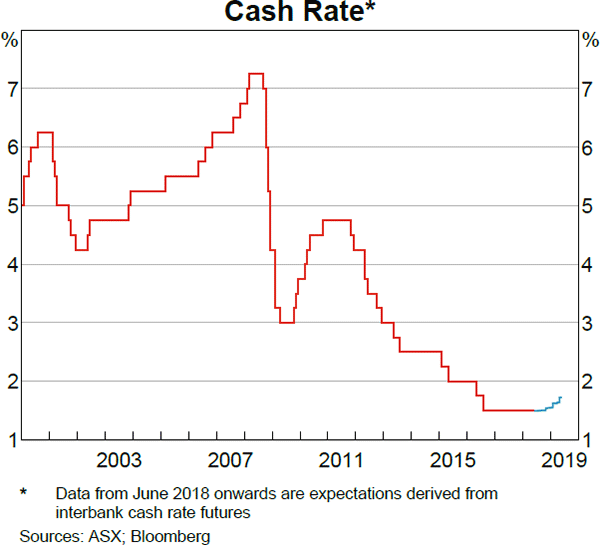
Government bond yields have been little changed
Yields on 10-year Australian Government Securities (AGS) have increased so far in 2018 to around 2.8 per cent, reflecting developments in international markets. Recently, the yield on US Treasury securities has risen above the yield of 10-year AGS for the first time since 2000 (Graph 3.2). Issuance from the Australian Office of Financial Management and state borrowing authorities has continued to be well received by the markets.

Conditions in short-term money markets have tightened modestly
Bank bill rates have increased in recent months, with spreads on 3- and 6-month bank bills relative to overnight indexed swaps (OIS) rising by about 30 basis points (Graph 3.3). This is a direct consequence of the increase in short-term bank funding costs in the United States (see the ‘International Environment’ chapter). Australian banks use US money markets to raise some of their funding for their Australian dollar assets. The higher cost of US dollar funds has meant that Australian banks have, at the margin, increased their demand for funding in domestic wholesale markets. This has contributed to an increase in the cost of Australian dollar funding for a range of financial institutions.
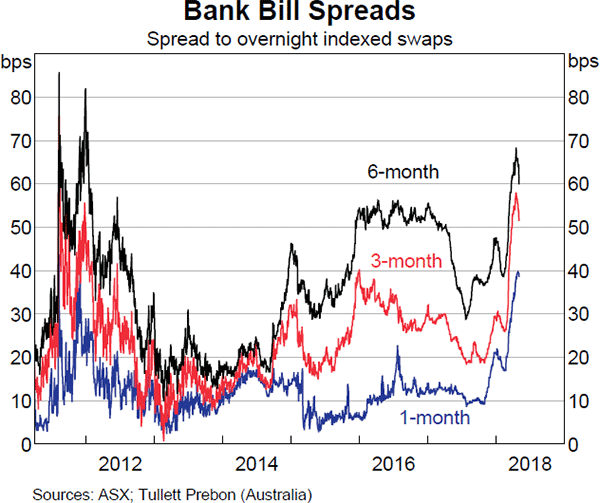
Short-term interest rates in the repurchase agreement (repo) market have also increased, and remain high at 40–50 basis points above OIS. This reflects, among other factors, heightened demand for secured funding from market participants, and is consistent with the rise in the cost of short-term funding in the bank bill market. However, while the increase in bank bill rates has implications for funding costs of financial institutions, the repo market is not a significant source of funding. Meanwhile, the cash rate has continued to trade at the Board's target.
Banks' funding costs have risen but remain low
The rise in interest rates in short-term money markets has led to an increase in the banks' overall debt funding costs since the beginning of the year. Funding costs have increased to be around the level that they were at around the end of 2016, which is still low compared with previous years.
Higher bank bill swap (BBSW) rates affect bank funding costs in a number of ways. First, BBSW rates flow through to the rates banks pay on their new short- and long-term wholesale debt (Graph 3.4). In addition to this effect, bank bond yields have increased by around 20 basis points since the start of the year.
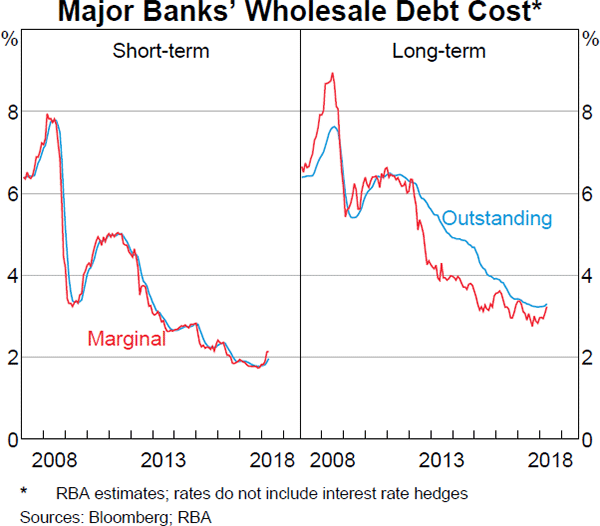
Second, the higher BBSW rates increase some of the costs associated with hedging the risks on banks' debt. Banks tend to issue fixed-rate bonds and then swap a sizeable share of these fixed interest rate exposures into floating rate exposures. This better aligns the interest rate exposure from their funding with their assets (which consist largely of variable interest rate loans). In doing this, the banks typically end up paying BBSW rates on their hedged liabilities, which flow through to the cost of funding.
Third, rates on wholesale deposits tend to be closely linked to BBSW rates, so the cost of these deposits is rising. Wholesale deposits include deposits from large corporations, pension funds and the government, and account for around 30 per cent of banks' debt funding.
The increase in BBSW has had little effect on retail deposit rates (Graph 3.5). While the relative cost of other sources of funding can influence the pricing of retail deposits, so too can other factors. Moreover, the interest rates on retail deposits are adjusted less frequently than rates on wholesale deposits. Over the year to date, retail deposit rates have decreased slightly, mostly reflecting declines in the rates on online saving accounts. Most, but not all, of these decreases occurred before the recent increase in BBSW.
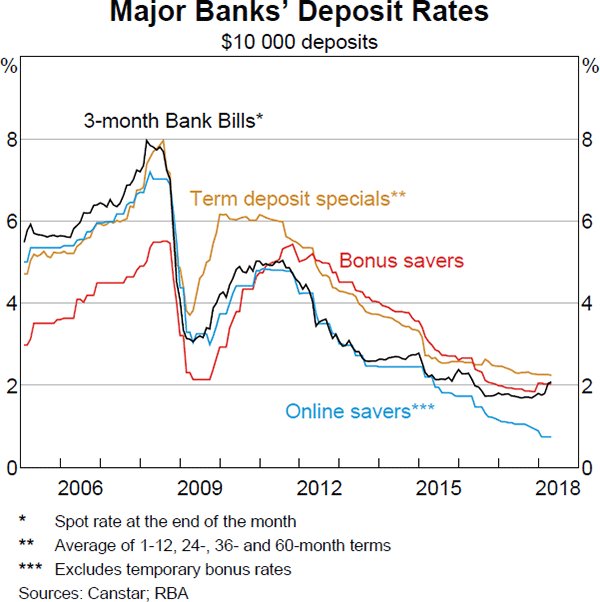
While some business lending rates are also closely linked to BBSW rates, and increase alongside the higher funding costs, there have been few signs as yet of mortgage rates changing in response to the increase in funding costs (lending rates are discussed further below). Hence the interest rate spread between major banks' lending rates and overall debt funding costs is estimated to have narrowed recently, though it remains higher than a few years ago.
Banks' issuance in wholesale funding markets has been sustained
Gross bond issuance by Australian banks has continued at a similar pace to previous years, with around $50 billion raised over the first four months of the year (Graph 3.6). However, net issuance has been above average given that bond maturities have been below average over the year to date.
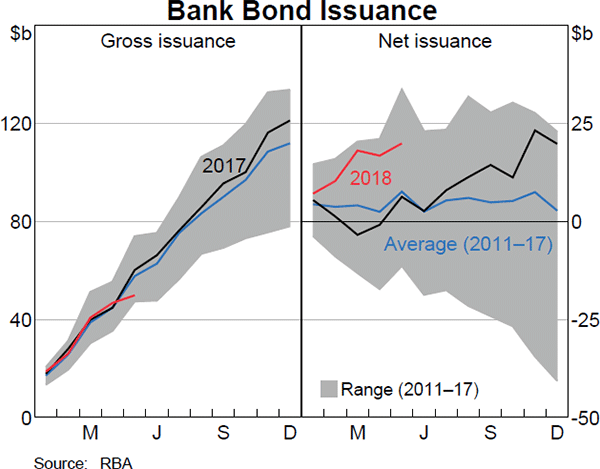
The overall composition of banks' funding was little changed over the year to March (Graph 3.7). The Net Stable Funding Ratio (NSFR), which requires banks to hold a minimum level of stable funding for their assets, came into effect on 1 January 2018. The banks have reported that they are above the regulatory minimum for the NSFR. Overall growth in banks' funding liabilities has been subdued, consistent with some moderation in credit growth.
Issuance of residential mortgage-backed securities (RMBS) has moderated from the strong pace seen in 2017 (Graph 3.8). Issuance has been driven largely by non-bank entities, with one deal by a major bank. Pricing for new deals has generally remained at lower spreads to BBSW than in recent years, although the increase in BBSW rates means that the absolute cost of issuing RMBS has risen of late.
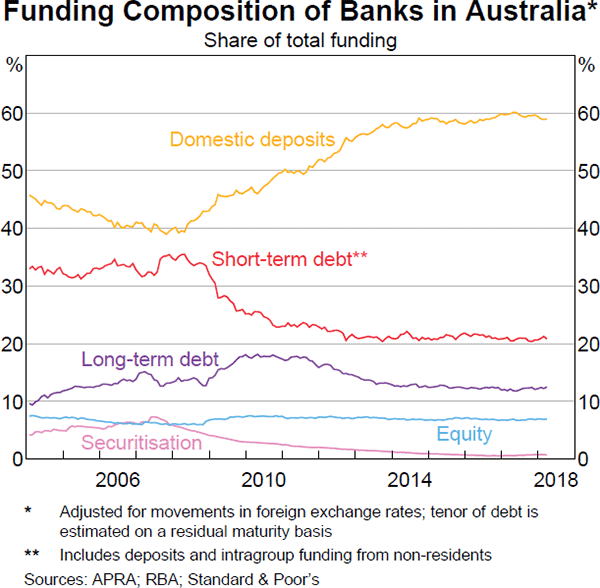
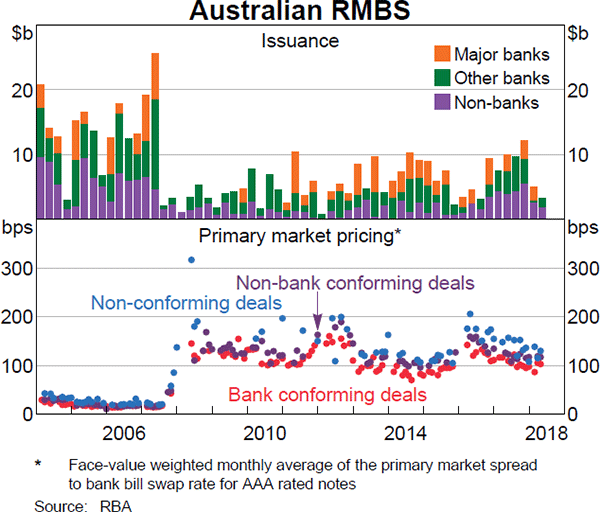
Some housing interest rates have declined a little
A number of lenders have reduced interest rates on new housing loans in recent months. A couple of lenders have reduced their advertised variable rates, particularly for investor and interest-only (IO) loans. In addition, the major banks made a number of targeted decreases to advertised rates on fixed-rate housing loans in early March, with the larger rate reductions tending to focus on investor and IO borrowers. Following this, some smaller banks also reduced their advertised fixed rates. These advertised rate decreases have been focused on new borrowers, while standard variable reference rates (which affect new and existing borrowers) have remained unchanged for the major banks. Two smaller lenders have raised their standard variable reference rates in response to the recent increase in funding costs.
Overall, data on securitised mortgages reported to the RBA indicate that the average outstanding rate for variable rate housing loans has declined by about 10 basis points since its recent peak in August 2017 (Graph 3.9; Table 3.1).[1] These data also confirm that new loans tend to be at lower variable rates than the average for outstanding loans. Moreover, new IO borrowers continue to pay a premium above the interest rate on new principal-and-interest (P&I) home loans (Graph 3.10).
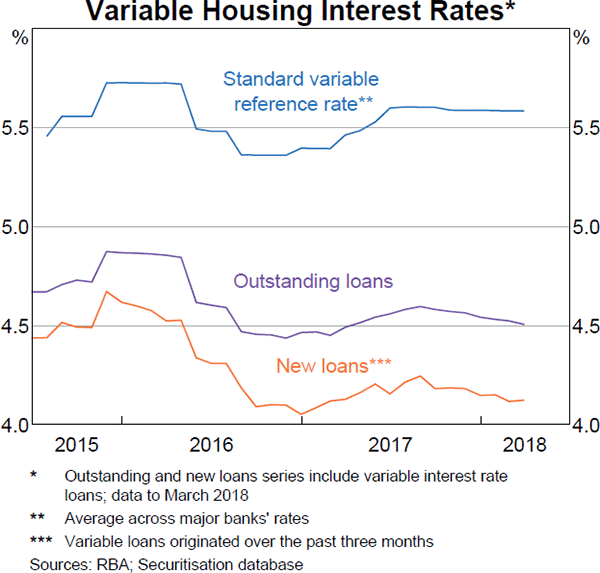
| Interest rate | Change since August 2017 | Change since November 2016 | |
|---|---|---|---|
| Per cent | Basis points | Basis points | |
| Housing loans(a) | |||
| – Variable principal-and-interest rate | |||
| – Owner-occupier | 4.27 | −8 | −14 |
| – Investor | 4.71 | −7 | 12 |
| – Variable interest-only rate | |||
| – Owner-occupier | 4.73 | −3 | 41 |
| – Investor | 5.07 | −4 | 58 |
| – Fixed rate | |||
| – Owner-occupier | 4.21 | −11 | −32 |
| – Investor | 4.34 | −7 | −26 |
| – Average outstanding rate | 4.48 | −9 | 3 |
| Personal loans | |||
| – Variable rate(b) | 11.65 | 2 | 16 |
| Small business | |||
| – Term loans variable rate(e) | 6.43 | 0 | 4 |
| – Overdraft variable rate(e) | 7.26 | −5 | −1 |
| – Fixed rate(c)(e) | 5.24 | −7 | −7 |
| – Average outstanding rate(d) | 5.29 | 1 | −6 |
| Large business | |||
| – Average outstanding rate(d) | 3.50 | 11 | 1 |
|
(a) Average rates from Securitisation Dataset, updated for end March
2018 Sources: ABS; APRA; Securitisation System; RBA |
|||
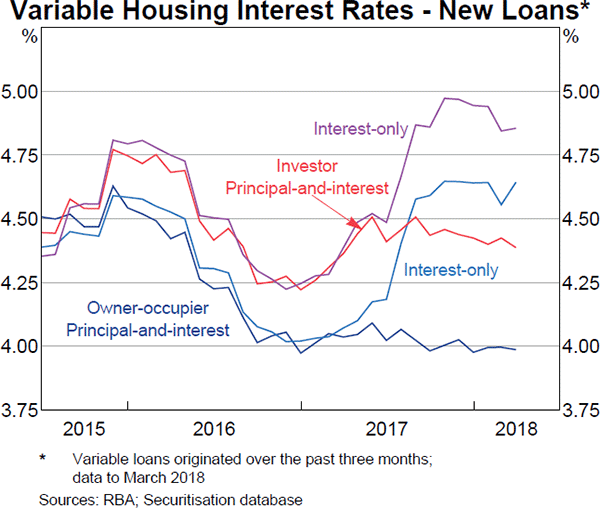
Housing credit growth has eased
Growth in housing lending to both investors and owner-occupiers has slowed since mid 2017 to around 2.5 per cent and 8 per cent, respectively (Graph 3.11; Table 3.2). The slower growth in lending to investors has reflected a decrease in IO lending, which is more prevalent among investors. This decrease followed the Australian Prudential Regulation Authority's (APRA's) measures to reinforce sound residential mortgage lending practices, particularly the requirement that authorised deposit-taking institutions (ADIs) such as banks limit new IO lending to 30 per cent of total new residential mortgage lending.
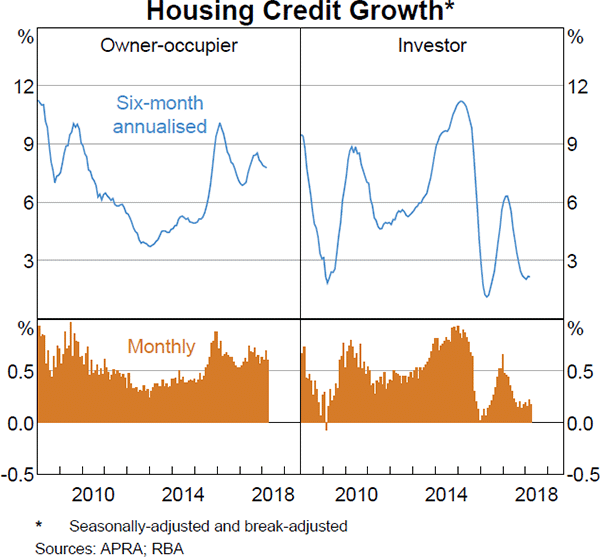
Recent liaison with banks suggests that some banks intend to modestly increase the growth of their new IO lending to certain lower-risk segments of the market as they are currently well below APRA's 30 per cent benchmark. Indeed, there has been some evidence of increased competition for such lending, with a number of banks having recently reduced the rates on some loans for investors, particularly IO loans.
Nevertheless, IO loans are likely to remain less prevalent than in recent years. Moreover, under the current regulatory and pricing environment, more borrowers are likely to convert to making P&I payments when their scheduled IO period expires compared with previous years. While the subsequent increase in mortgage payments will not be trivial for some households, at the aggregate level the increase in payments is likely to amount to a small proportion of household disposable income and the effect on household consumption growth is expected to be smaller still (see Box C: ‘The Expiry of Interest-only Loan Terms’).
The growth of housing credit extended by non-ADI lenders exceeds that by ADIs. Recent liaison suggests that non-ADIs have been lending to some borrowers who would typically have borrowed from ADIs in the absence of APRA's measures to tighten lending standards and limit IO mortgages. Nevertheless, lending by these institutions remains small as a share of housing credit, at less than 5 per cent.
| Three-month ended | Year-ended | ||
|---|---|---|---|
| Dec 2017 | Mar 2018 | Mar 2018 | |
| Total credit | 1.1 | 1.2 | 5.1 |
| – Housing | 1.4 | 1.5 | 6.1 |
| – Owner-occupier housing | 1.9 | 1.9 | 8.1 |
| – Investor housing | 0.5 | 0.6 | 2.5 |
| – Personal | −0.4 | −0.2 | −1.0 |
| – Business | 0.9 | 0.8 | 4.2 |
| Broad money | 0.1 | 1.1 | 3.8 |
|
(a) Seasonally-adjusted and break-adjusted Sources: ABS; APRA; RBA |
|||
The value of housing loan approvals (excluding refinancing) has continued to decline over recent months, to be 8 per cent below the recent peak in August 2017. This has been driven by investors, with owner-occupier approvals remaining relatively steady since mid 2017 (Graph 3.12). The decline in investor approvals has been primarily concentrated in New South Wales. Loan approvals for refinancing (with a different lending institution) have increased since the beginning of the year, consistent with borrowers shopping around for better deals (Graph 3.13).
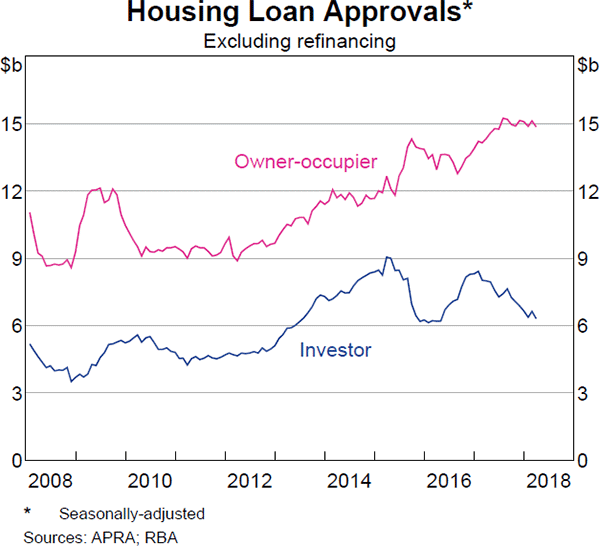
In late April, APRA – in consultation with the Council of Financial Regulators – announced plans to remove its 10 per cent investor loan growth benchmark from 1 July 2018 for ADIs that can demonstrate that their lending policies and practices meet APRA's expectations. As part of these measures, APRA will also require ADIs to develop internal limits on the proportion of new lending at very high debt-to-income levels, taking into account each applicant's total borrowings.
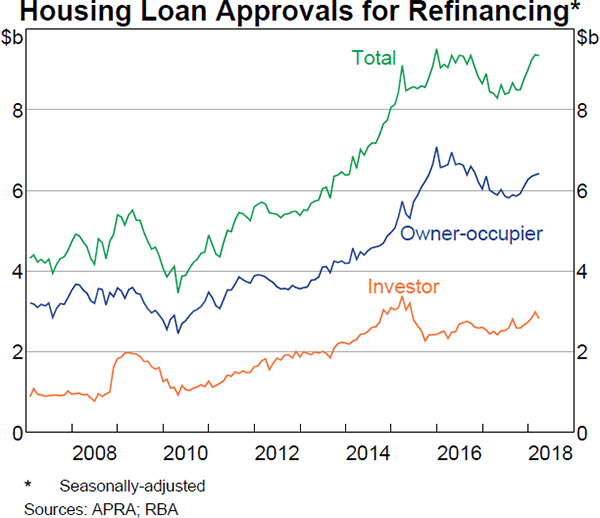
Funding is readily available for most businesses
Growth in a broad measure of business debt has risen a little over recent months (Graph 3.14). This has been driven by increased bond issuance, and a pick-up in syndicated lending by institutions that do not report their lending to APRA (that is the ‘other lending’ category). Overall, growth in business debt has been moderate in recent years at around 5 per cent in year-ended terms, despite interest rates being at low levels and a pick-up in business investment outside the mining industry. In part, the growth in business debt remains moderate because businesses tend to finance much of their investment from internal funding.
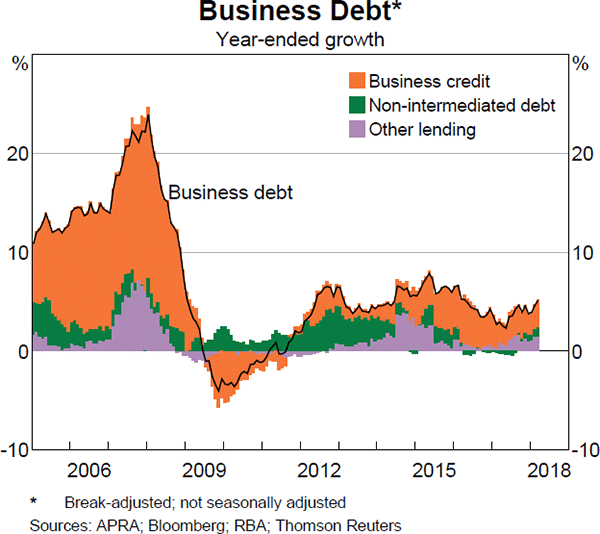
Rapid growth in foreign bank lending to businesses over the past five years saw the Australian banks' share of business credit decline to just under 75 per cent, around its lowest level since the financial crisis (Graph 3.15). However, the major banks' share of business loan approvals has risen over the past year; at the same time, their share of new lending to households for residential property has declined (Graph 3.16).
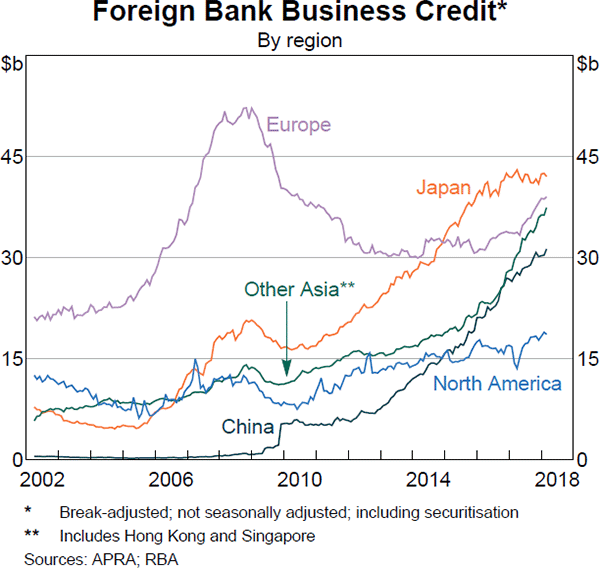
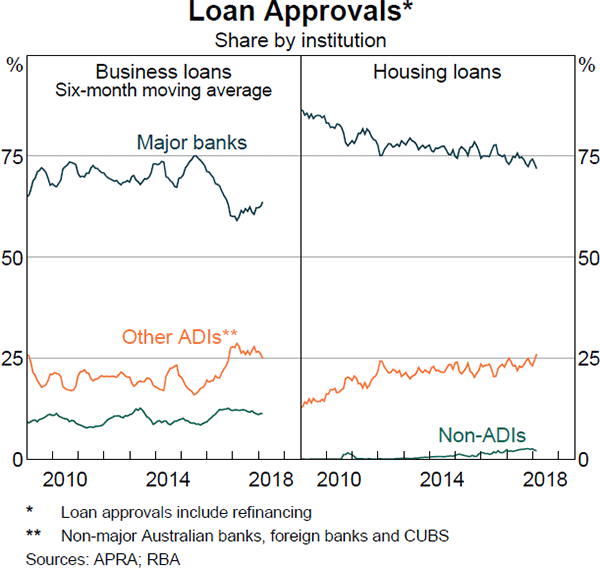
Interest rates on business loans are close to historically low levels. The interest rates on many large business loans are closely linked to BBSW rates. As a result, the increase in BBSW rates is gradually flowing through to an increase in large business lending rates. In contrast, the link between variable rates on small business loans and BBSW rates is less direct; the interest rates on outstanding variable-rate loans to small businesses have been little changed since mid 2017.
Bond issuance by Australian non-financial corporations has been moderate since the start of the year, although it has exceeded maturities. Issuance continues to be mainly from utilities and infrastructure companies, with relatively little issuance from resource companies. While the cost of issuance has increased by around 15 basis points since the start of the year, spreads to benchmark rates for non-financial corporate bonds remain low (Graph 3.17).
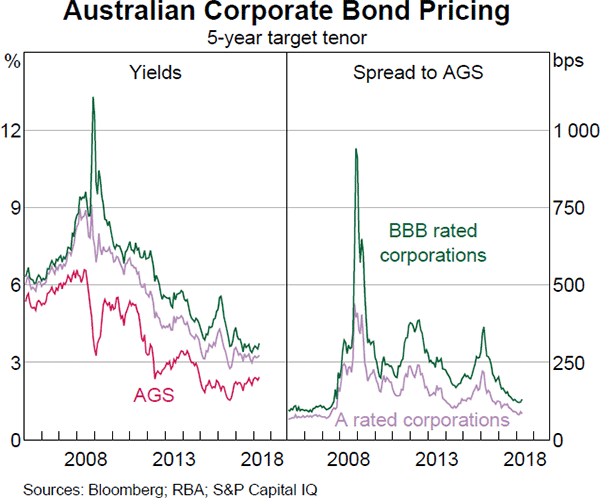
Australian equity prices are little changed
Australian equity prices are around their levels at the end of 2017 (Graph 3.18). Market volatility picked up at the start of the year from the very low levels observed in 2017, but has since eased somewhat.
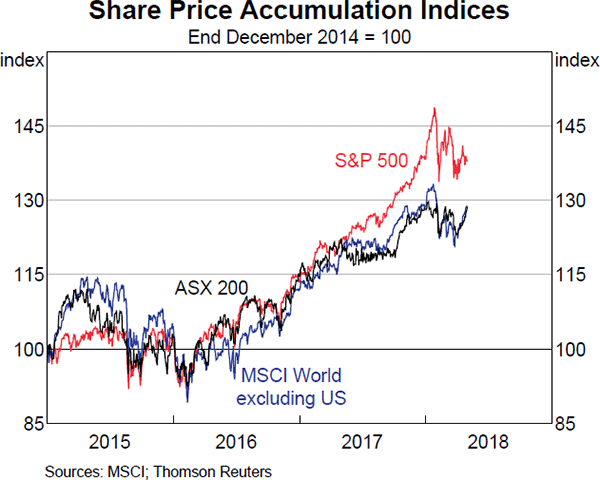
Since the start of the year, banks' share prices have fallen by around 5 per cent, more than the market as a whole. Share prices of the resources sector have risen recently, alongside a pick-up in certain commodity prices (Graph 3.19). Companies' share prices outside the resources and financial sectors have been mixed, with a decline in the telecommunications sector somewhat offset by increases in the healthcare sector.
Analysts' earnings expectations have been revised steadily higher this year, particularly for the resources sector (Graph 3.20). Nonetheless, price-to-earnings ratios for most sectors remain slightly above their long-run averages.
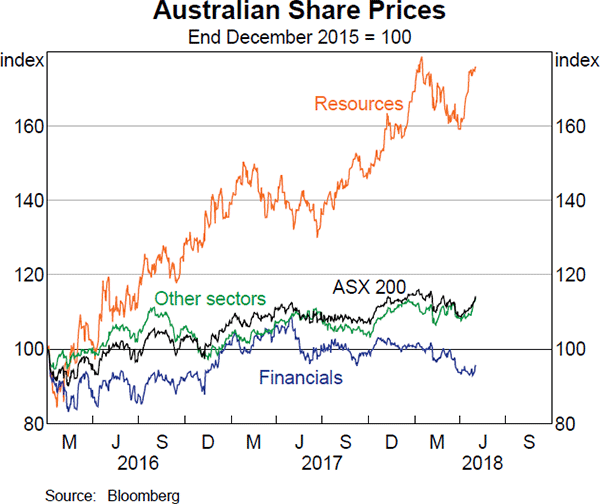
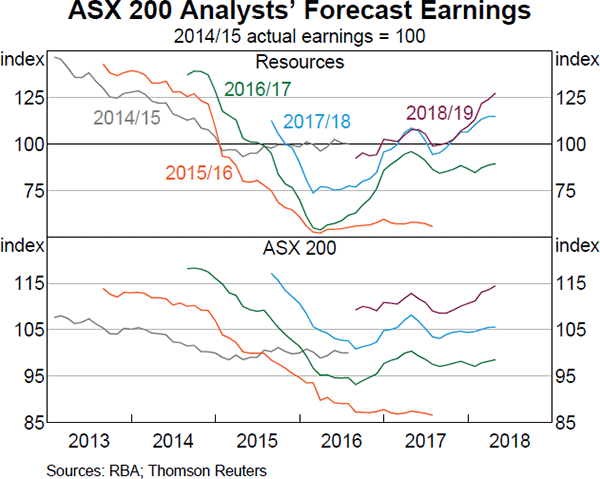
Corporate profits have grown over the past year
Aggregate underlying profits for ASX 200 companies were 13 per cent higher in the second half of 2017 than the same period in 2016, as increases in commodity prices supported profits in the resources sector. Resource companies continued to use the increase in cash flows to pay down debt and raise shareholder dividends (Graph 3.21).
The underlying profits for the financial sector were mixed, with larger-than-anticipated costs from natural disasters weighing on insurance companies' profits.
Underlying profits for companies outside the resources and financial sectors increased compared with the same period last year. Property revaluation gains supported earnings of real estate companies, while infrastructure companies – supported by increased inbound international travel and higher toll revenues – boosted profits in the broader industrials sector.
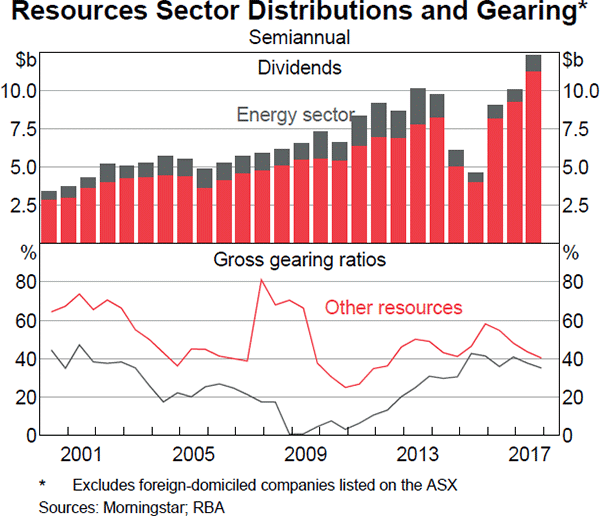
The Australian dollar remains within its narrow range of the past two years
Increases in bulk commodity prices, supported the Australian dollar over the past two years. However, narrowing interest rate differentials between Australia and other economies have worked in the other direction. Since the start of the year, the Australian dollar has depreciated against the US dollar and on a trade-weighted basis (TWI), as bulk commodity prices have declined and interest rate differentials have continued to narrow (Graph 3.22).
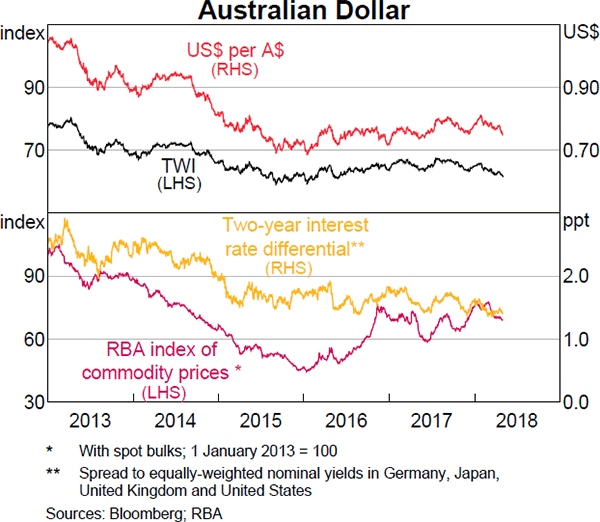
Net capital inflows are lower than in recent years
Net capital inflows to Australia remain modest, consistent with the low level of the current account deficit (Graph 3.23). There were small inflows into the financial sector over 2017, following several years of outflows as banks repaid foreign-held debt. There were outflows from the mining sector, as mining investment projects that are largely foreign owned and funded approached completion. Australia's net foreign liability position has declined over the past couple of years. At around 55 per cent of GDP, it is close to its average level since 2000.
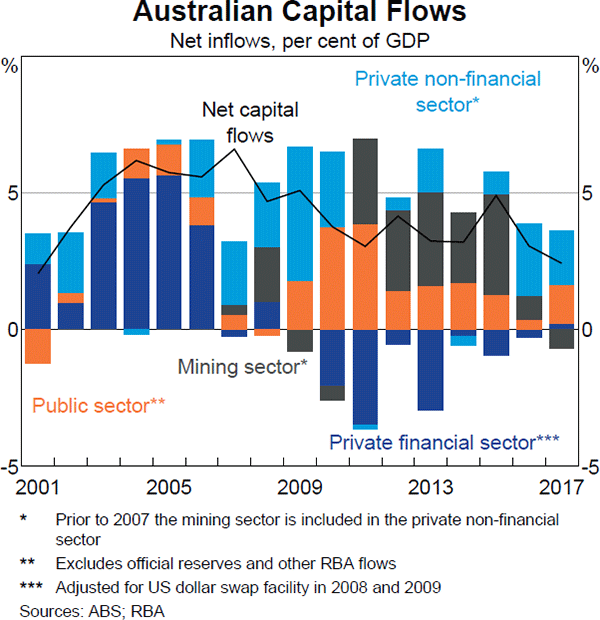
Footnote
The Reserve Bank collects detailed information on asset-backed securities it accepts as collateral in its domestic market operations. Most of these securities in the Securitisation Database are underpinned by residential mortgages, covering around $400 billion of mortgages or about one-quarter of the total value of housing loans in Australia. Loans in the database may have different characteristics from those not covered by the database. See Kent C (2017), ‘Some Innovative Mortgage Data’, Speech at Moody's Analytics Australia Conference 2017, Sydney, 14 August. See also Kohler M (2017), ‘Mortgage Insights from Securitisation Data’, Speech at Australian Securitisation Forum, Sydney, 20 November. [1]